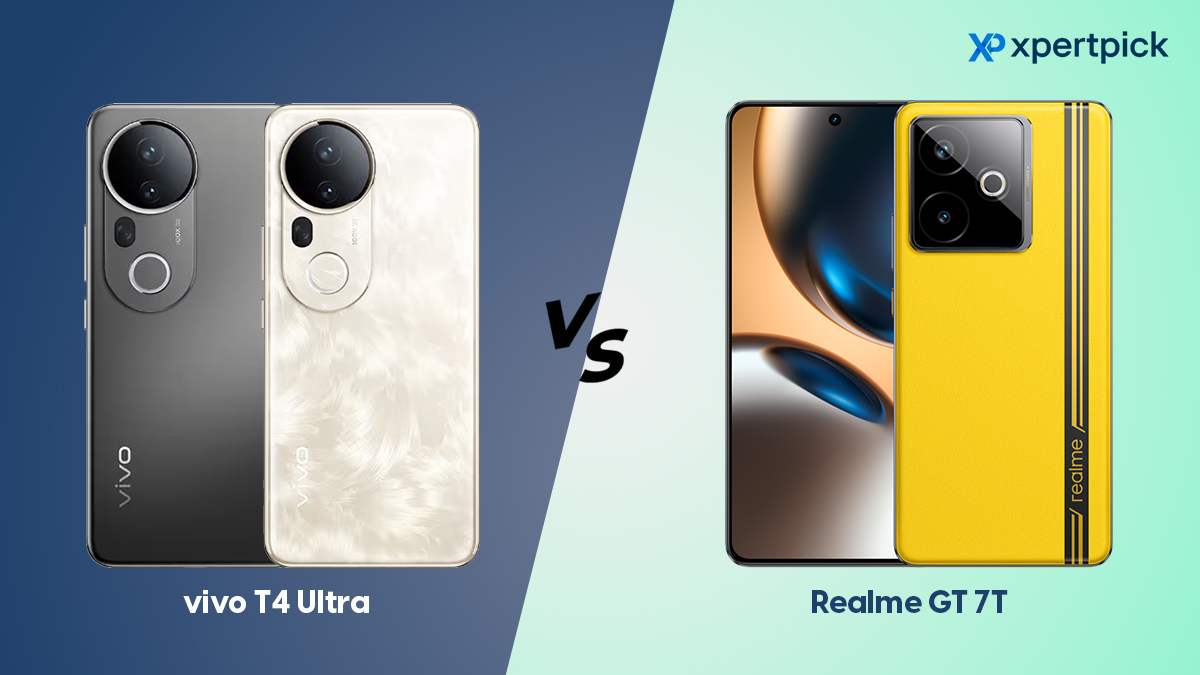
The Vivo T4 Ultra comes as the top-of-the-line T-series smartphone from the brand. It brings performance upgrades, a new display panel, and camera upgrades over the standard Vivo T4. It brings a 10x telephoto macro zoom and the flagship-grade MediaTek Dimensity 9300 Plus SoC to the lineup. But are these upgrades enough to help the T4 Ultra take on the Realme GT 7T, which is one of the best smartphones money can buy in this price segment? To determine this, we compared both devices extensively, and here’s what we found.
Build and Design
| Specs | Vivo T4 Ultra | Realme GT 7T |
| Thickness | 7.43 mm | 8.25mm |
| Weight | 192 grams | 202g |
| IP rating | IP64 | IP69 |
The Vivo T4 Ultra draws inspiration from the standard V50, featuring a pill-shaped camera module with a triple camera sensor and an Aura light flash. The smartphone is available in Meteor Grey and Phoenix Gold, with the former being a solid paint job while the latter features a shimmering finish with a brush stroke pattern beneath the glass.
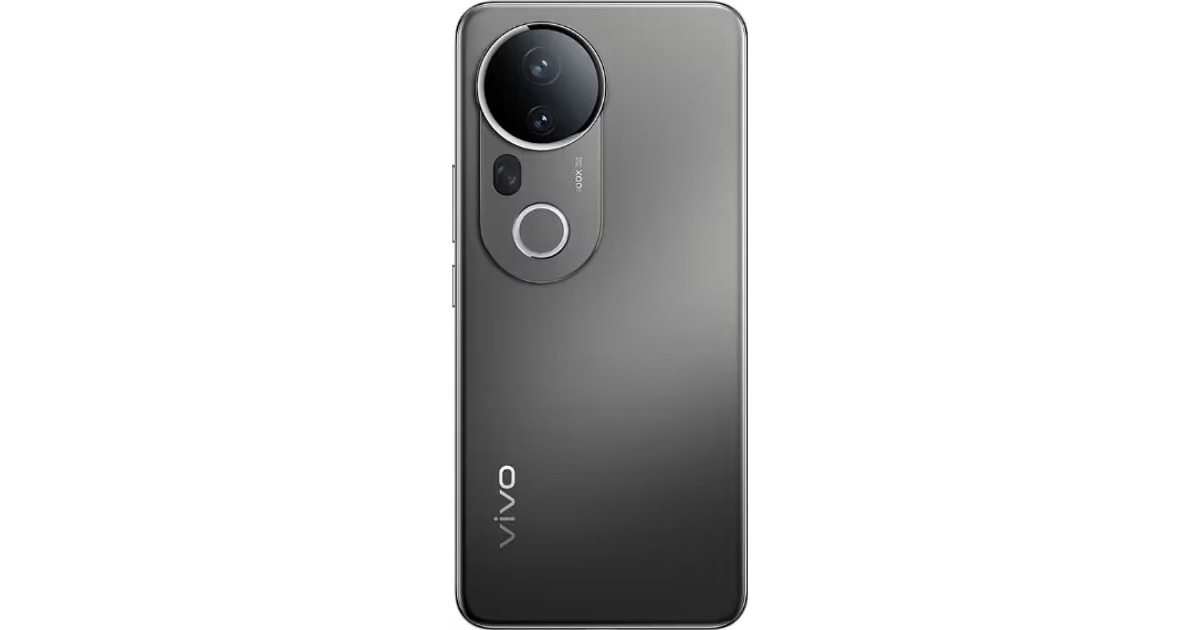
The Vivo T4 Ultra has an all-plastic build, which makes it considerably lightweight and manageable for prolonged durations. The device compensates for the lack of confidence that comes with its heft by boasting an IP64 rating, which protects it against minor splashes of water and dust. Lastly, the handset is quite sleek, measuring 7.43mm, and weighs only 192 grams.
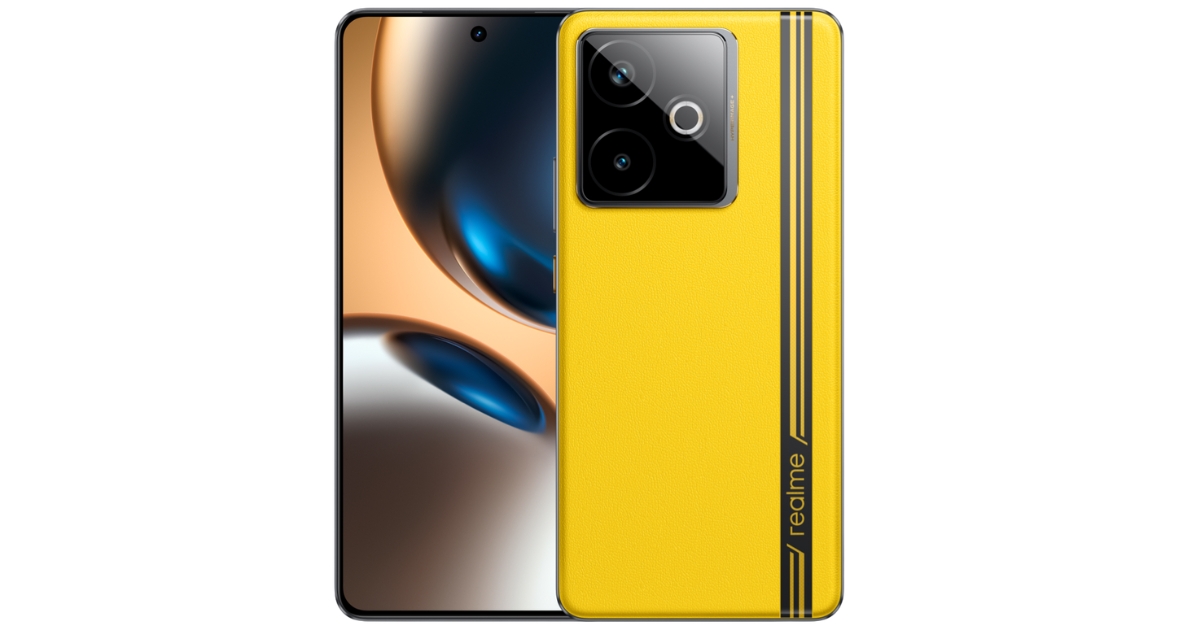
Coming to the Realme GT 7T, it comes in IceSense Black, IceSense Blue, and Racing Yellow. The Yellow colour variant boasts a vegan leather back panel with a racetrack-inspired stripe. All three variants weigh close to 200 grams and are 8.25mm thick. Granted, the Realme offering is bulkier and heavier than the Vivo offering, but it comes with several design upgrades over its rival.
For starters, the vegan leatherette finish on the yellow variant gives it a premium look while also being resistant to wear and tear. The Black and Blue variants have graphene at the back for better cooling. Moreover, the handset also comes with a flagship-grade IP69 rating for better durability.
If you are looking for a smartphone that’s sleek and lightweight, making it comfortable for prolonged usage, then the Vivo T4 Ultra is the one to opt for. However, if a modern design and better durability are your priorities, then the Realme GT 7T is the one to choose.
Display
| Specs | Vivo T4 Ultra | Realme GT 7T |
| Size | 6.67 inches | 6.8 inches |
| Resolution | 2,800 x 1,260 pixels | 2,800 x 1,280 pixels |
| Refresh Rate | 120Hz | 120Hz |
| Peak Brightness | 5000nits | 6000nits |
| Protection | Unspecified | ArmorShell Glass |
The Vivo T4 Ultra features a stunning AMOLED display measuring 6.67 inches from corner to corner diagonally. It boasts a 1.5 K resolution, a 120Hz refresh rate, 5,000 nits of peak brightness, and HDR10+ support for high-resolution streaming. However, due to the lack of an LTPO panel, the device lacks the dynamic refresh rate, which automatically adjusts the refresh rate based on the display content to conserve battery.

Nevertheless, the display can still adjust the refresh rate down to 60Hz, thanks to its adaptive refresh rate features, and offers a great viewing experience. The panel also supports 5,000 nits of peak brightness, making it one of the brightest in its segment. The only drawback here is that the brand has not specified whether the display has a protective layer.

Moving on to the Realme GT 7T, the device features a slightly larger 6.8-inch AMOLED display panel with the exact resolution and refresh rate, as well as HDR 10+ support. The smartphone offers a higher 6,000nits of peak brightness. The display is protected by a layer of ArmorShell Glass for drop and scratch protection.
The difference between displays of these devices is minuscule, and for the viewing experience, you can pick either one; it wouldn’t matter. However, if you are someone who frequently drops their phone and needs the peace of mind that comes with display protection, the Realme GT 7T offers it.
Cameras
| Specs | Vivo T4 Ultra | Realme GT 7T |
| Primary Camera | 50MP Sony IMX921, f/1.88 | 50MP Sony IMX896, f/1.8 |
| Secondary Camera | 50MP Sony IMX882 3x Periscope Camera, f/2.55 | 8MP wide-angle, f/2.2 |
| Tertiary Camera | 8MP ultrawide, f/2.2 | – |
| Video Recording | 4K, 1080p, 720p | 4K, 1080p |
| Selfie Camera | 32MP, f/2.45 | 32MP, f/2.4 |
Coming to the cameras, both smartphones offer a 50MP primary sensor, but while Vivo T4 Ultra offers a triple camera setup, the Realme GT 7T has a dual camera system. The T4 Ultra flaunts a 50MP Sony IMX921 primary lens, with a bigger sensor size and will offer better image and video quality compared to the Realme GT 7T’s smaller IMX896 50MP primary lens.

The secondary lens on both smartphones is a wide-angle lens with an 8MP sensor. The Vivo T4 Ultra features a third camera, a segment-first 50MP OIS periscope lens paired with a 10x telephoto unit that includes a macro mode. In case you are looking for a more versatile and powerful camera smartphone, the Vivo T4 Ultra fits the bill
Performance and Software
The Vivo T4 Ultra is powered by the flagship MediaTek Dimensity 9300+ SoC, a first for the Indian smartphone market. The Realme GT 7T, on the other hand, is powered by the MediaTek Dimensity 8400-MAX chipset, a slightly enhanced version of the Dimensity 8400. We ran AnTuTu, Geekbench 6, and Burnout apps on these smartphones to gauge their performance.
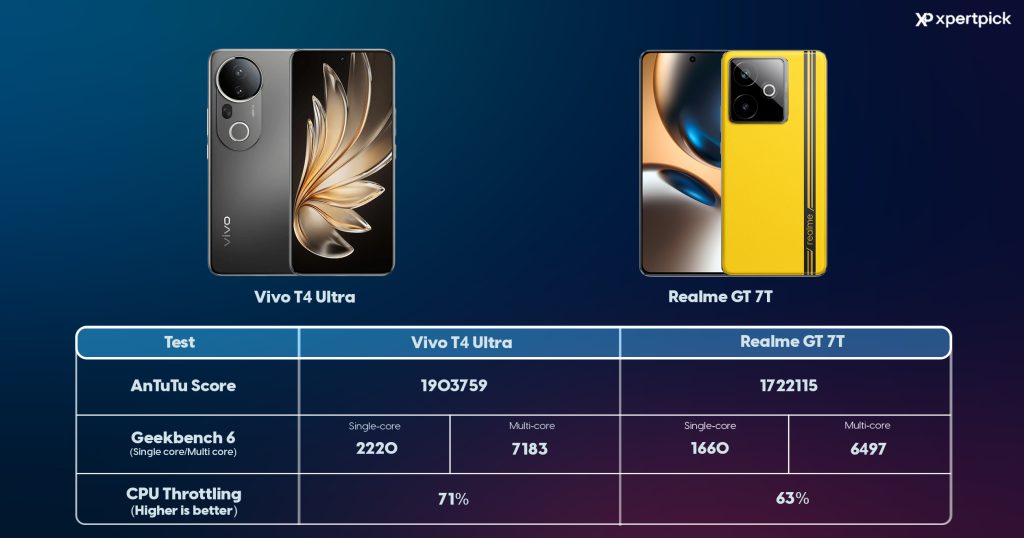
The AnTuTu benchmarking app is the gold standard for measuring device performance, as it accounts for four core metrics to determine the overall prowess of the device: CPU, GPU, Memory, and UX. In this test, the Vivo T4 Ultra scored 1903759, which is only 10% higher than Realme GT 7T’s 1722115 score.
Coming to Geekbench 6, the app measures the CPU’s prowess in both lightweight daily tasks and resource-intensive tasks through single-core and multi-core tests. The Vivo T4 Ultra scored around 30% higher in the single-core and 10% higher in the multi-core test.
The benchmarking scores are fine, but the real test of a smartphone is its sustained performance under prolonged, heavy usage. We ran a CPU throttling test on both smartphones to measure the performance drop off when the CPU cores’ frequency is restricted to prevent overheating. The Vivo T4 Ultra maintained 71% of its maximum performance, as compared to 63% sustained by the Realme GT 7T.
Both smartphones are capable performers when it comes to daily and intensive tasks. If you are a normal user, you won’t be able to spot a difference in the performance of these devices in daily usage. However, if you are a power user who prefers a consistent and sustained performance over a longer duration, the Vivo T4 Ultra should be your pick.
As for the software, the Vivo T4 Ultra runs Android 15-based Funtouch OS 15 custom skin out of the box. The Realme GT 7T boots Realme UI 6.0 based on Android 15.
Battery and Charging
The Vivo T4 Ultra is powered by a 5,500mAh battery that supports 90W wired fast charging. On the other hand, the Realme GT 7T comes with a massive 7,000mAh battery with 120W fast wired charging. Both brands are providing a compatible charger with the device.
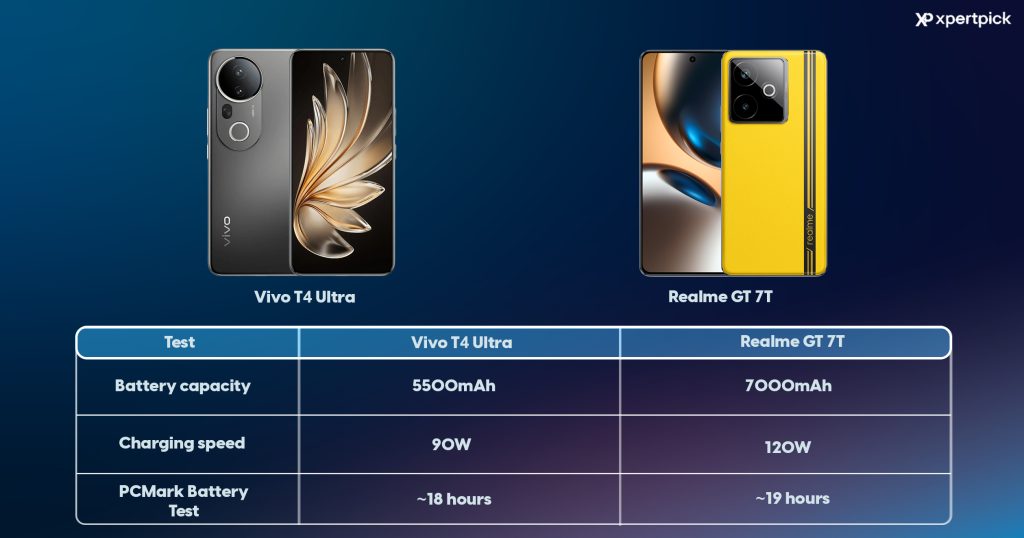
In our PCMark battery test, the Vivo T4 Ultra lasted almost 18 hours on a full charge. In comparison, the Realme GT 7T lasted around 19 hours, which is not a significant difference to be a dealbreaker. If battery backup is your priority, you can pick either of these two and enjoy the same experience.
Verdict
The Vivo T4 Ultra has been launched with a starting price tag of Rs 37,999, while the GT 7T can be purchased at Rs 34,999 for its base variant. For the markup in the price, the Vivo T4 Ultra offers the best-in-class camera setup, superior sustained performance, good battery life, and more.
The Realme GT 7T is a good contender that offers a much solid design with display protection and a larger battery. It also delivers almost similar performance, but loses out in the camera department. In a nutshell, if you want a better performer, then go for the Vivo T4 Ultra. Pick the Realme GT 7T if design, durability, and battery are your priority.














